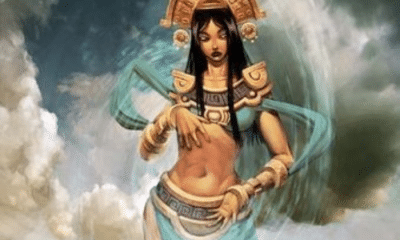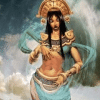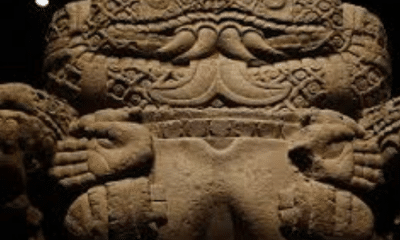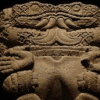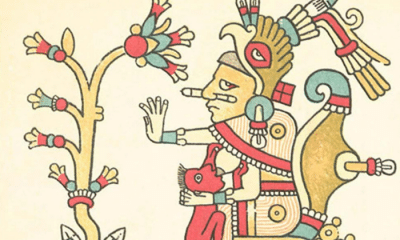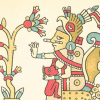
Aztec
Who Was Tezcatlipoca in Aztec Mythology?
Who Was Tezcatlipoca in Aztec Mythology?
Keep reading to find out more about Tezcatlipoca and why he’s so difficult to pick out in many images from pre-Columbian Mexico.
In the Aztec religion, Tezcatlipoca was an important god. He was involved in the earth’s creation, commanded jaguars, oversaw sacrifices, and presided over the night sky.
Sometimes he was shown as a partner in creation, but more often he was shown as a god of judgment and destruction. According to Aztec cosmology, he had been responsible for destroying the world four times before the current age of mankind began.
Despite all this, however, he is rarely seen in art. His missing leg often identifies him, but other images remain elusive.
So who was Tezcatlipoca and why is his imagery so hard to pinpoint? The answer may lie outside the Aztec culture, among their Mesoamerican neighbors.
The “Invisible God” Tezcatlipoca
Tezcatlipoca is sometimes described as an invisible god. This is not because of any supernatural power, but because he is so rarely seen in surviving images from the Aztec culture.
Often, however, it is simply that these images may be difficult to identify. Tezcatlipoca served many different functions, so he was depicted in similarly diverse ways.
Most often, the god is associated with the creation of the world. Many different myths existed to explain this, however.
He was usually described as the brother of one of the greatest creation gods, Quetzalcoatl. They were two of the four sons of Ometecuhtli and Omecihuatl, the lord and lady who had created all the gods and the first humans.
Sometimes, these brothers were described as the four Tezcatlipocas, distinguished by color. He was associated with the color black, while Quetzalcoatl was the White Tezcatlipoca.
In one version of the creation story, the two worked together to create the world.
Before they created the land, all that existed was the sea. In it lived a monstrous reptile known as Cipactli.
The brothers needed to capture Cipactli to make her body into the land. Tezcatlipoca used his foot as bait, so he can sometimes be identified in art because his missing foot is replaced with smoking obsidian, a bone, or a snake.
In a story that seems to have been more widespread, however, Tezcatlipoca and Quetzalcoatl were rivals. This is known as the legend of the Five Suns.
When the world was created, Tezcatlipoca made himself the sun. Because he was missing a leg, however, he could only be half a sun, so Quetzalcoatl knocked him out of the sky with a stone club.
Tezcatlipoca turned himself into a jaguar and ripped the world apart. The first age, called the Sun of the Earth or the Jaguar Sun, was destroyed.
Quetzalcoatl then became the sun himself. He was overthrown by Tezcatlipoca, who saw that the people who lived under Quetzalcoatl were animalistic and uncivilized.
He turned these people into monkeys, which Quetzalcoatl blew from the earth with a great wind. This was the Sun of the Wind.
After this Tlaloc, the god of rain, became the sun. Tezcatlipoca stole Tlaloc’s wife and the rain god was so distraught that he caused a drought.
When the people of this world begged him to send rain, Tlaloc grew so annoyed that he sent a rain of fire to kill them all. The gods made a new world from the ashes, ending the Sun of Rain.
The only people who survived this sun became birds, who could go into the air to escape the burning earth.
Tlaloc’s new wife, the kindly water goddess Chalchiuhlicue, became the Sun of Water. Tezcatlipoca accused her of faking this kindness, however.
Chalciuhlicue was so hurt by this accusation that she cried for fifty-two years. The world was inundated by the flood her tears caused and the people became fish to survive.
The Aztecs believed that they lived under the fifth sun, Huitzilopochtli. They continued to give sacrifices to Tezcatlipoca to prevent him from once again judging the sun and the people who lived under it, to be unworthy.
If that happened, they believed, Huitzilopochtli would become the Sun of Earthquakes. Tezcatlipoca would use earthquakes to destroy the world while the Tzitzimimeh, the jealous stars, killed their brother Huitzilopochtli.
Like many Aztec gods, Tezcatlipoca was associated with a wide variant of domains. He was a god of night, hurricanes, leadership, sacrifices, jaguars, conflict, beauty, and the earth.
My Modern Interpretation
One reason there are different myths regarding Tezcatlipoca and different ways of showing him is that the Aztecs were not a single unified culture.
The Aztecs of the classical era were a confederation of several Mesoamerican groups. These Mexican cultures were closely related, but often had local variations on their shared myths.
They were also closely related to other nearby cultures, both those that existed at the same time and ones that predated them.
Archaeologists believe that Texcatlipoca was directly inspired by gods of some of these other cultures. The Aztecs were known to take inspiration from earlier cultures, specifically the Maya and Olmec.
Both of these cultures worshipped a jaguar god who closely resembled Tezcatlipoca, who used his totem animal to destroy the world in the myth of the Five Suns.
The Mayan god Tohil, for example, was similarly associated with sacrifice. His name means “obsidian,” which is both shown on Tezcatlipoca’s body and reflects the color most commonly associated with him.
Another Mayan god is shown with even more obvious physical connections to the later imagery of Tezcatlipoca. K’awil was shown with a missing leg that was replaced by a snake.
Tezcatlipoca was sometimes shown with an obsidian leg or breastplate that emitted smoke, giving him his name that translates as “Smoking Mirror.” K’awil had an obsidian knife in his forehead that smoked as well.
Every Mesoamerican culture had some form of jaguar god that, because of the big cat’s nature, was usually associated with night and strength. This alone is not enough to definitively link Tezcatlipoca to an earlier deity, but the additional similarities in his representation strengthen the theory.
While historians agree, therefore, that Tezcatlipoca was likely influenced by earlier Mayan and Olmec versions of the archetype, they are less sure about how this happened.
One theory proposes that Tezcatlipoca was directly descended from these earlier gods. He was, in essence, the same god who had been renamed in the language of the newer Aztec culture.
Another idea, however, is that Tezcatlipoca’s mythology and imagery changed in response to earlier gods.
Some historians believe that Tezcatlipoca developed independently, or at least without direct influence, from the Mayan gods that he resembles.
The Maya culture predated the Aztec, but it also existed to the south of it. Its post-classical period coincided with the height of Aztec culture and the two had contact through both trade and conflict.
The Aztec people recognized that the Maya belonged to an older culture and, like the Romans did with the Greeks in Europe, often emulated their art and religious practices. Mayan elements were thus sometimes added to those from Olmec and Aztec regions.
Some historians believe, therefore, that some elements of Tezcatlipoca were adopted from the Maya after the god himself had developed independently. Imagery like his missing leg and smoking obsidian was not original to the Aztec god, but was added to resemble a Mayan deity.
When Mayan imagery was adopted, Tezcatlipoca’s myth changed to reflect the new elements of his representation.
This interpretation explains some of the different legends of Tezcatlipoca as well as the difficulty in identifying him. His image was varied in Aztec art because Mayan elements were not consistently added in different times and places of the Aztec Empire.
In Summary
In Aztec mythology, the god Tezcatlipoca represented many domains. These included night, leadership, conflict, and beauty.
Tezcatlipoca was often believed to have been one of the creators of the world, but he was most often associated with destruction. The world was destroyed four times before the current age, the Aztecs believed, and all these cataclysms were because of Tezcatlipoca.
He was also closely associated with the practice of sacrifice. Only by pacifying the gods could humanity prevent Tezcatlipoca from judging the world unworthy for a fifth time.
Historians believe that Tezcatlipoca was influenced by the gods of other Mesoamerican cultures. The Olmec were the direct ancestors of the Aztec, while the ancient Maya culture survived in southern Mexico and Central America.
There is no agreement, however, in how Tezcatlipoca came to resemble Mayan deities.
Some believe that he was directly modelled after these gods from the beginning. Others think that Tezcatlipoca belonged to a similar archetype, but Mayan imagery was added after his cult was already established.


